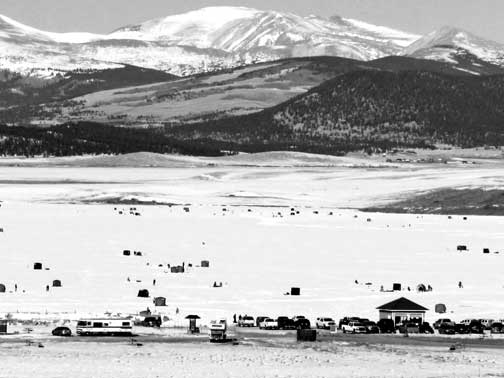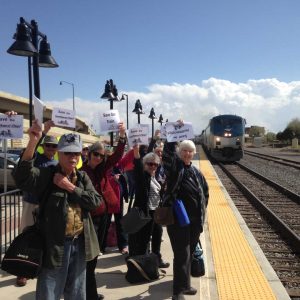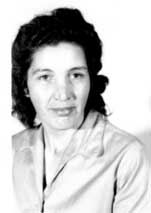
By Laura Van Dusen
Antero, the sun-sparkled, windswept reservoir hidden behind low rolling hills seven miles west of Hartsel, will be drained beginning June 1 to repair and strengthen the leaking 106-year-old dam; water will flow downstream to Cheesman, Marston and Chatfield reservoirs.
It’s nothing new. According to Denver Water, this drain is the eighth for Antero since the urban utility took over ownership in 1924. In 1958, water was gradually released to comply with a dam restriction. That drain continued until 1963 when Antero was completely emptied due to drought. In 1996 Antero was drained to rebuild the outlet works; in all other years the drain was due entirely to drought.
Antero’s maximum twenty-foot depth, typically held at eighteen feet, is shallow for a Denver reservoir. In future drought years, to minimize evaporation, Antero will likely be emptied again.
The Beginning
Antero’s beginning traces back to 1877, when English capitalists decided to build an irrigation ditch through Denver. They proposed it would transform the surrounding dry prairie into an oasis of trees, flowers and gardens and aid farmers and ranchers. The construction contract for the High Line Canal was signed in November 1879.
The canal made a wonderful improvement to the new city, and hundreds of men were employed to build it. Crops and cattle were healthy, and the city was vibrant with shade and fruit trees and picturesque gardens. Land values boomed with what was thought to be an inexhaustible water supply.
Trouble
The first sign of trouble was a short article in the Jan.16, 1886 Rocky Mountain News. It seems there were more applications for water use than could be carried in the ditch for the next growing season. The story said it was “a good indication of the rapid development” of Denver, which was good news if the High Line Canal Company could meet increasing demands.
But demands couldn’t be met, and that was not the only problem.
The High Line was the first canal the South Platte River encountered after passing through Platte Canyon southwest of Denver. Every possible drop of water was diverted into it. In the summer of 1886, ditches that irrigated farmlands northeast of Denver near Greeley – fields that had priority water rights over the High Line – went dry. Cattle there were dying of thirst; even the native pronghorn were suffering. At the same time the High Line was reported to be “six feet deep and 40 feet wide” running through Denver, according to the July 16, 1886 Rocky Mountain News.
And it got worse. In June 1890, floodgates to Weld County canals were closed due to an order from the state engineer’s office, because, the News of June 28 said, water commissioners “find it politic [diplomatic] to side with those people with whom they come most in contact.”
A temporary injunction ordered the canal gates open, and angry farmers and ranchers guarded them. They put up signs threatening to kill anyone who would dare shut the gates on their canal again. Court suits continued for years as details of early Colorado water law were decided.
[InContentAdTwo]
South Park
It wasn’t long before the High Line Canal affected water rights in South Park.
In the summer of 1890, a judge in Colorado Springs ordered 25 South Park ditches shut down so that water could flow downriver to the High Line. As a result, in August 1890, the South Park Ranchmen’s Protective Association was formed to protect what ranchers believed to be their right to “use as much water as is necessary for irrigating purposes.”
The irrigated crop was South Park hay, famous throughout the state for its superior quality. (Rocky Mountain News, Aug. 4, 1890.)
Glimmer of Antero
The July 1, 1891 Rocky Mountain News said an immense basin – Antero Reservoir – was to be filled with water as a solution to the High Line Canal problems. The paper said Antero, along with Castlewood Reservoir in Douglas County and the proposed Lost Park Reservoir, downstream from Antero, were considered the main water supply for Denver.
(Castlewood Dam, built in 1890, broke in August 1933. It flooded downtown Denver and was not repaired. It is now a focal point of Castlewood Canyon State Park near Franktown. Lost Park Reservoir, its former site surrounded by Lost Creek Wilderness in Park County, was a failed attempt to dam Lost Creek. It didn’t hold water because, true to the name, the creek was “lost.” It flowed underground in the area of the dam.)
According to the News story, the site for Antero had been examined several years earlier as an available location to build a reservoir. It said planners at that time met with “a difficulty of securing the funds.” Curiously, in the otherwise straightforward story, one sentence was unclear and unexplained. It said, “Intelligence from the East (italics added) indicates that work may be commenced before the close of the present season.”
An explanation of “intelligence from the East” could be that the man who owned the Antero site, Peter W. Sheafer, was from the East. His work as a renowned coal mine engineer, land surveyor and geologist took him all over the U.S. from his Pottsville, Pennsylvania base. It can be speculated that Sheafer didn’t want to sell the Antero property and that when he died in New Jersey on March 26, 1891, the Antero site was reconsidered.
The leader behind the Antero plans in 1891 was Cyrus Greenwood Richardson, a Denver attorney. He owned $1 million worth of land (26 million in 2015 dollars) with High Line Canal water rights, including the 3,200-acre Greenwood Ranch that is today’s upscale Denver suburb, Greenwood Village. His plan was to sell water from Antero Reservoir to owners of the High Line.
The first step in building Antero was to acquire the land. In 1892 Richardson put up $10,000 of his own money, and attorney Charles H. Burton, who had represented Richardson in another case, began legal condemnation proceedings of the Antero land using Colorado’s Eminent Domain Law (the right to take property for private use if the acquisition is necessary for reservoirs, drains, flumes or ditches for agricultural, mining, milling, domestic or sanitary purposes). The law provides that the owner be justly compensated for the condemned property.
The estate of Peter W. Sheafer and his heirs, including 25 family members, and the Benevolent Association, the Children’s Home and the Methodist Episcopal Church – all of Pottsville – settled in November 1892. Their lawyer accepted $18,500 (in 2015 dollars, that’s $487,000) for the tract of land that would become Antero Reservoir.
Richardson’s untimely death in 1894 at age 52 delayed the plans to build Antero until 1907.
Building the Dam
The Antero project was taken over in April 1907 by several investors, including another wealthy Denver landowner with property along the High Line, Brad DuBois. But he at least had interests in South Park.
In 1896 DuBois and Felix Leavick bought the Hill Top Mine near the town of Leavick, along present day County Road 18 southwest of Fairplay. Together they built an 11-mile railroad spur – the Fairplay, South Park and Hilltop – to service the mines along that route. They also built the mill that is still standing on the side of the road near Leavick. DuBois had interests in Leadville mines as well; at one time he owned the Chrysolite, and he discovered the Maid of Erin.
In May 1907, Antero project organizers held a meeting with people who owned land along a proposed extension of the High Line between Denver and Greeley. DuBois suggested to the group that a reservoir be built at the Antero site to be owned by all High Line Canal landowners. He said, “With the completion of our new reservoir, we will have practically unlimited water supply.”
Thirty-three landowners incorporated in October 1907 with capital of $2 million, according to the Oct. 25, 1907 Fairplay Flume. It was called the Antero and Lost Park Reservoir Company, also known as the Antero Company. The plan was to build two reservoirs – Antero and Lost Park. Contracts were signed in April 1908, with Horace G. Clark appointed as president. Less than a year later, the group bought the High Line Canal; the name was changed to the Antero Land and Irrigation Company and but was still called the Antero Company.
That summer, several hundred men were hard at work in South Park. A headline in the Flume of August 7, 1908, said the “Great Antero Dam” would soon begin storing water. By June 1909 the water was nine feet deep.
Litigation
Ranchers in South Park could watch only so long as less water flowed down the South Platte and into the ditches they had used since the early 1860s. In the summer of 1910, the South Park Ranchmen’s Protective Association brought suit in Denver District Court, accusing the Antero Company of “impounding water contrary to law,” according to the July 15, 1910 Flume. The ranchmen said that 4.5 times more water came into Antero than was released below the dam. The reservoir company filed a counterclaim against the ranchmen, saying they were taking water that they had no right to take.
They were both right. The Antero Company, when reporting the amount of water that flowed into the reservoir, counted only water coming in from the main channel of the South Platte River, not the numerous small streams and springs that also fed Antero. And the South Park ranchers didn’t close their headgates when ordered to by the state water commissioner. Even when the headgates were closed, they were set so high that plenty of water flowed underneath to provide irrigation.
The essence of the two suits concerned priority water rights.
(Colorado water law, then and now, gives priority, or first, water rights to the party who is first to physically take water from a stream or aquifer for a beneficial use. The priority has to be by court decree, or adjudication, verifying who has priority status. If two or more parties have senior rights, then domestic use is given priority over agricultural use.)
The judge ruled in favor of the reservoir company and ordered all South Park ranchmen be restricted from opening the headgates to their ditches to capture either the direct flow of the river or water released from the reservoir. The division engineer and the water commissioner from Denver were in South Park the day after the ruling to close down all headgates on the Middle and South Forks of the South Platte south and east of Fairplay; they hired guards to enforce compliance.
In May 1911, another judge ruled that as much water as flows into the reservoir should flow out of Antero; simultaneously the water commissioner closed all South Park ditches with priority dates later than May 6, 1866, which blocked all but two South Park ditches.
A celebration was held in June 1913 in fields east of Denver when the High Line Canal Extension was opened. Thousands of people witnessed Governor Elias Ammons christen the “great Antero system” that was expected to “turn 60,000 acres of barren land into green, productive fields.” (See the June 27, 1913 Routt County Republican.)
Three years later, the extension could not supply enough water for sugar beet fields near Greeley. Antero Company president Clark told farmers to blame “the lawless ditch owners of South Park” for stealing water, according to a letter by Clark printed in the Record-Journal of Douglas County, June 16, 1916, and reprinted on July 7 in the Flume.
Clark also attributed the lack of water to the engineering firm hired to dig the extension, Henry L. Doherty and Company, accusing it of failing to build the system according to specifications. When the promised water couldn’t be supplied through the extension, Clark refused to pay Doherty. The real reason for non-payment, historians have speculated, was that negotiations were in process for sale of the system to Denver.
The underlying cause was that the canal could not supply all the water the Antero Company had sold.
Sale to Denver
In 1915, the population in the city of Denver was nearing a quarter of a million people. By 1920 it was the 25th most populous city in the nation, and its citizens needed more water. On Aug. 21, 1915, the Public Utilities Commission of Denver made an offer to buy Antero Reservoir and the High Line Canal for its municipal water system.
Almost as soon as the contract was announced, an injunction was filed by Doherty to prevent the sale until his company was paid for the High Line Extension work. The litigation, and other suits related to the failure of the canal to supply water to farmers’ fields, lasted for five years. The suits were settled in the Antero Company’s favor in November 1920. Denver Water, who took over as water supplier for the city in 1918, finalized the contract with the Antero Company and has owned both Antero Reservoir and the High Line Canal since 1924.
Today
Antero, along with four other reservoirs and a natural lake, provide South Park water to Front Range cities. Their impact on the ranching industry is huge. In 1930, South Park supported up to 394 ranches in a vast sea of grassy meadows. By 1950 only 120 working ranches remained. In 2015, 19 ranches in South Park retain full pre-1900 water rights; and about six more retain a portion of original water rights or have acquired other senior water rights. Only six of those operate as year-round ranches.
Antero Reservoir has a decreed capacity of 85,000 acre-feet (an acre-foot is the amount of water it takes to cover one acre of land to a depth of one foot). That is equal to a 36-foot depth at the Antero site. Since the 1920s state engineers have limited the capacity of Antero to 20,000 acre-feet or less (equal to an 18-foot depth) due to the dam’s dirt construction. The completed 2015 dam will bear a depth of 26 feet; Denver Water has posted on its website that Antero will be held at 18 feet for the foreseeable future.
The High Line Canal, a designated National Landmark Trail, has extremely limited irrigation use today. It is a 66 mile-long scenic recreational trail, winding through Douglas, Arapahoe and Denver counties from Waterton Canyon to the Green Valley Ranch subdivision.
Laura Van Dusen writes from her cabin near Como. She tends to dive in head first and leave no stone unturned in her search for South Park history.




